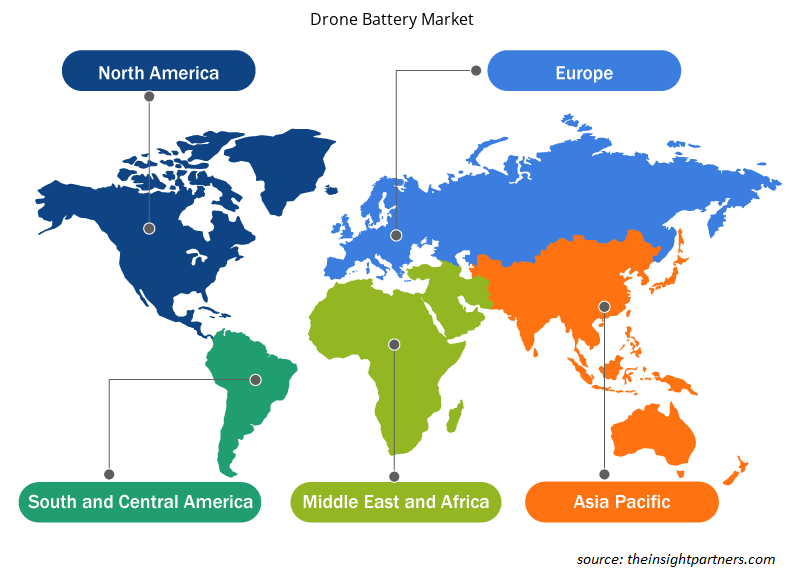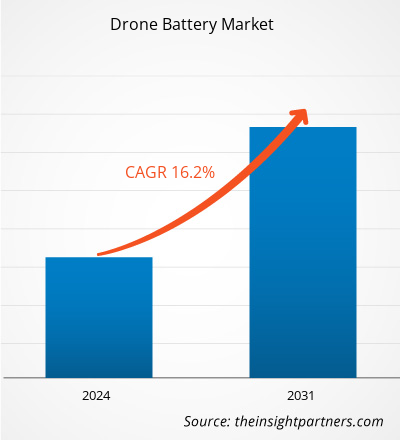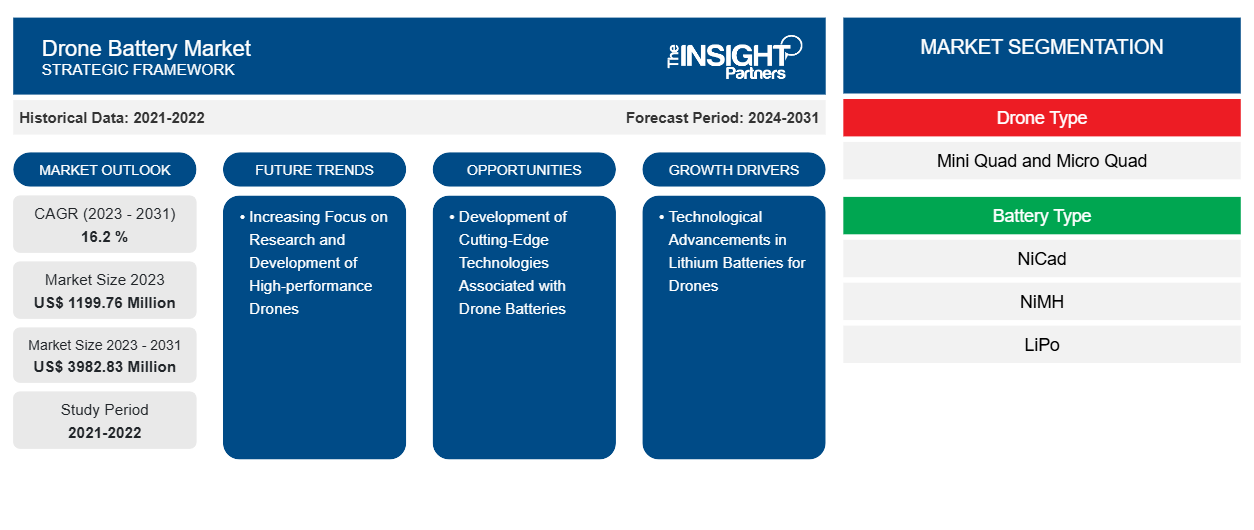Si prevede che la dimensione del mercato delle batterie per droni raggiungerà i 3982,83 milioni di dollari entro il 2031, rispetto ai 1199,76 milioni di dollari del 2023. Si prevede che il mercato registrerà un CAGR del 16,2% nel periodo 2023-2031. È probabile che la crescente attenzione alla ricerca e allo sviluppo di droni ad alte prestazioni rimanga una tendenza chiave nel mercato.CAGR of 16.2 % during 2023–2031. Increasing focus on research and development of high-performance drones is likely to remain a key trend in the market.
Analisi del mercato delle batterie per droni
Il mercato globale delle batterie per droni è guidato principalmente dalla crescente adozione di droni in una varietà di applicazioni come rilevamento, mappatura e monitoraggio. Inoltre, il crescente numero di start-up di droni sta guidando l'espansione del mercato delle batterie per droni a livello globale. Ad esempio, il numero totale di start-up di droni in India è aumentato del 34% tra agosto 2021 e febbraio 2022. Tali fattori stanno offrendo opportunità per il mercato delle batterie per droni in India.
Panoramica del mercato delle batterie per droni
Le batterie per droni sono batterie ricaricabili che possono essere utilizzate per i droni. Sono generalmente realizzate in polimeri di ioni di litio (Li-ion) o polimeri di litio (LiPo) e sono disponibili in varie dimensioni e capacità. Le batterie per droni sono necessarie per tempi di volo più lunghi e possono rappresentare un possibile rischio di incendio se non gestite correttamente. Il tipo di batterie utilizzate dal drone può essere un fattore importante per il funzionamento del drone, incluso il tempo necessario per la carica tra un utilizzo e l'altro e la velocità di scarica. Le batterie per droni più utilizzate sono quelle ai polimeri di litio (LiPo), al nichel-cadmio (NiCad) e agli ioni di litio (Li-ion).LiPo) and come in various sizes and capacities. Drone batteries are necessary for longer flight times, and they pose a possible fire hazard if not properly handled. The type of batteries your drone uses can be an important factor in how the drone functions, including the time it takes to charge between uses and the rate of discharge. The most widely used drone batteries are Lithium Polymer (LiPo), Nickel Cadmium (NiCad), and
Personalizza questo report in base alle tue esigenze
Riceverai la personalizzazione gratuita di qualsiasi report, comprese parti di questo report, o analisi a livello nazionale, pacchetto dati Excel, oltre a usufruire di grandi offerte e sconti per start-up e università
-
Scopri le principali tendenze di mercato in questo rapporto.Questo campione GRATUITO includerà analisi di dati che spaziano dalle tendenze di mercato alle stime e alle previsioni.
Driver e opportunità del mercato delle batterie per droni
Progressi tecnologici nelle batterie al litio per i droni
I droni hanno registrato una notevole crescita a livello globale negli ultimi anni. A causa dell'aumento della sicurezza delle frontiere e dell'intrusione nemica, diversi governi e aziende si concentrano sull'acquisto di UAV. Ad esempio, nel 2022, la Federal Aviation Administration (FAA) ha segnalato che negli Stati Uniti nel 2023 sono stati registrati 855.860 droni. Pertanto, con la crescente domanda di droni, si prevede che il mercato delle batterie continuerà a crescere in modo significativo durante il periodo di previsione. Inoltre, l'aumento delle associazioni di droni specifiche per paese come la Czech Unmanned Aerial Alliance di recente formazione, l'Association du drone de l'industrie française (ADIF) in Francia e numerose altre in Asia, tra cui la Korea Drone Industry Association, la Korea Drone Association, la Shenzhen UAV Industry Association e la Japan UAS Industrial Development Association sta anche integrando la crescita del mercato delle batterie per droni.UAVs. For instance, in 2022, the Federal Aviation Administration (FAA) reported that 855,860 drones were registered in the US in 2023. Therefore, with the increasing demand for drones, the battery market is expected to continue to grow significantly during the forecast period. Further, increasing country-specific l’Association du drone de l’industrie française (ADIF) in France, and numerous others in Asia, including Korea Drone Industry Association, the Korea Drone Association, Shenzhen UAV Industry Association, and the Japan UAS Industrial Development Association is also supplementing the growth of drone battery market.
Sviluppo di tecnologie all'avanguardia associate alle batterie dei droni
Gli operatori di mercato stanno sviluppando continuamente batterie con una resistenza interna inferiore aumentandone la tensione di carica. Queste batterie supporteranno droni con densità più elevata, maggiore capacità delle celle, massa inferiore e massima densità di potenza richiesta per tempi di volo più lunghi. Produttori come Amprius Technologies e KULR TECHNOLOGY GROUP, INC. stanno anche sviluppando batterie di nuova generazione con una densità energetica di 400 Wh/kg e un ciclo di carica/scarica di almeno 1.000 volte. Pertanto, si prevede che lo sviluppo di tecnologie all'avanguardia associate alle batterie per droni genererà opportunità redditizie per la crescita del mercato durante il periodo previsto.Amprius Technologies and KULR TECHNOLOGY GROUP, INC. are also developing next-generation batteries with an energy density of 400 Wh/kg and a charge/discharge cycle of at least 1,000 times. Thus, the development of cutting-edge technologies associated with drone batteries is anticipated to generate lucrative opportunities for market growth during the forecasted period.
Analisi della segmentazione del rapporto sul mercato delle batterie dei droni
I segmenti chiave che hanno contribuito alla derivazione dell'analisi di mercato delle batterie per droni sono il tipo di drone, il tipo di batteria, la capacità della batteria e il settore.
- In base al tipo di drone, il mercato delle batterie per droni è diviso in mini quad e micro quad. Il segmento mini quad ha detenuto una quota di mercato maggiore nel 2023.
- In base al tipo di batteria, il mercato è segmentato in NiCad, NiMH e LiPo.NiCad, NiMH, and LiPo.
- In base alla capacità della batteria, il mercato è suddiviso in inferiore a 3.000 mAh, 3.000-5.000 mAh, 5.000-10.000 mAh e superiore a 10.000 mAh.mAh, 3,000-5,000 mAh, 5,000-10,000 mAh, and Above 10,000 mAh.
- In base al settore, il mercato è segmentato in agricoltura e silvicoltura, ispezione delle infrastrutture, servizi di pubblica utilità, edilizia, attività minerarie e altri.
Analisi della quota di mercato delle batterie per droni per area geografica
L'ambito geografico del rapporto sul mercato delle batterie per droni è suddiviso principalmente in cinque regioni: Nord America, Asia Pacifico, Europa, Medio Oriente e Africa, Sud e Centro America.
Il Nord America domina il mercato delle batterie per droni. Si prevede che questi investimenti e finanziamenti aiuteranno i fornitori di droni ad espandere le loro attività e a fornire soluzioni agli utenti finali di vari settori. La crescente domanda di droni spinge la necessità di batterie nel Nord America, il che probabilmente gioverà al mercato delle batterie per droni nella regione.
Approfondimenti regionali sul mercato delle batterie per droni
Le tendenze regionali e i fattori che influenzano il mercato delle batterie per droni durante il periodo di previsione sono stati ampiamente spiegati dagli analisti di Insight Partners. Questa sezione discute anche i segmenti e la geografia del mercato delle batterie per droni in Nord America, Europa, Asia Pacifico, Medio Oriente e Africa e Sud e Centro America.

- Ottieni i dati specifici regionali per il mercato delle batterie per droni
Ambito del rapporto sul mercato delle batterie dei droni
| Attributo del report | Dettagli |
|---|---|
| Dimensioni del mercato nel 2023 | 1199,76 milioni di dollari USA |
| Dimensioni del mercato entro il 2031 | 3982,83 milioni di dollari USA |
| CAGR globale (2023-2031) | 16,2% |
| Dati storici | 2021-2022 |
| Periodo di previsione | 2024-2031 |
| Segmenti coperti |
Per tipo di drone
|
| Regioni e Paesi coperti |
America del Nord
|
| Leader di mercato e profili aziendali chiave |
|
Densità degli operatori del mercato delle batterie per droni: comprendere il suo impatto sulle dinamiche aziendali
Il mercato delle batterie per droni sta crescendo rapidamente, spinto dalla crescente domanda degli utenti finali dovuta a fattori quali l'evoluzione delle preferenze dei consumatori, i progressi tecnologici e una maggiore consapevolezza dei vantaggi del prodotto. Con l'aumento della domanda, le aziende stanno ampliando le loro offerte, innovando per soddisfare le esigenze dei consumatori e capitalizzando sulle tendenze emergenti, il che alimenta ulteriormente la crescita del mercato.
La densità degli operatori di mercato si riferisce alla distribuzione di aziende o società che operano in un particolare mercato o settore. Indica quanti concorrenti (operatori di mercato) sono presenti in un dato spazio di mercato in relazione alle sue dimensioni o al valore di mercato totale.
Le principali aziende che operano nel mercato delle batterie per droni sono:
- AMIT Industries LTD
- Tecnologia Amperex limitata
- Robotica Autel
- MMC-UAV
- Società di intelligenza artificiale SES
- Drone Pappagallo SAS
Disclaimer : le aziende elencate sopra non sono classificate secondo un ordine particolare.

- Ottieni una panoramica dei principali attori del mercato delle batterie per droni
Notizie e sviluppi recenti sul mercato delle batterie per droni
Il mercato delle batterie per droni viene valutato raccogliendo dati qualitativi e quantitativi dopo la ricerca primaria e secondaria, che include importanti pubblicazioni aziendali, dati associativi e database. Di seguito sono elencati alcuni degli sviluppi nel mercato delle batterie per droni:
- RRC Power Solutions GmbH ha adottato una strategia di doppio sourcing per prevenire carenze di fornitura. La strategia aiuta l'azienda a sviluppare pacchi batteria standard esistenti come RRC2054 e a pianificare lanci di prodotti con tempi di consegna più brevi. (Fonte: RRC Power Solutions GmbH, comunicato stampa, maggio 2022.)
- EaglePicher Technologies ha fornito la tecnologia essenziale delle batterie per alimentare sia il modulo dell'equipaggio della navicella spaziale Orion sia il sistema di terminazione del volo Space Launch System (SLS) utilizzato nel lancio Artemis I della NASA. EaglePicher Technologies fornisce batterie agli ioni di litio ricaricabili da 120 volt che alimentano il modulo dell'equipaggio, che consiste in comunicazioni, propulsione, navigazione e controllo termico. (Fonte: EaglePicher Technologies, comunicato stampa, agosto 2023)
Copertura e risultati del rapporto sul mercato delle batterie per droni
Il rapporto “Dimensioni e previsioni del mercato delle batterie per droni (2021-2031)” fornisce un’analisi dettagliata del mercato che copre le seguenti aree:
- Dimensioni e previsioni del mercato delle batterie per droni a livello globale, regionale e nazionale per tutti i principali segmenti di mercato coperti dall'ambito
- Tendenze del mercato delle batterie per droni e dinamiche di mercato come driver, vincoli e opportunità chiave
- Analisi dettagliata delle cinque forze PEST/Porter e SWOT
- analisi del mercato delle batterie per droni che copre le principali tendenze del mercato, il quadro globale e regionale, i principali attori, le normative e i recenti sviluppi del mercato
- Analisi del panorama industriale e della concorrenza che copre la concentrazione del mercato, l'analisi della mappa di calore, i principali attori e gli sviluppi recenti nel mercato delle batterie per droni
- Profili aziendali dettagliati
- Analisi storica (2 anni), anno base, previsione (7 anni) con CAGR
- Analisi PEST e SWOT
- Valore/volume delle dimensioni del mercato - Globale, Regionale, Nazionale
- Industria e panorama competitivo
- Set di dati Excel
Report recenti
Rapporti correlati
Testimonianze
Motivo dell'acquisto
- Processo decisionale informato
- Comprensione delle dinamiche di mercato
- Analisi competitiva
- Analisi dei clienti
- Previsioni di mercato
- Mitigazione del rischio
- Pianificazione strategica
- Giustificazione degli investimenti
- Identificazione dei mercati emergenti
- Miglioramento delle strategie di marketing
- Aumento dell'efficienza operativa
- Allineamento alle tendenze normative























 Ottieni un campione gratuito per - Mercato delle batterie per droni
Ottieni un campione gratuito per - Mercato delle batterie per droni